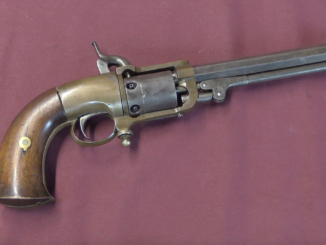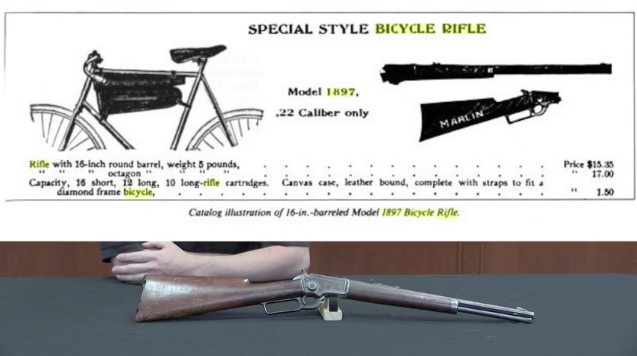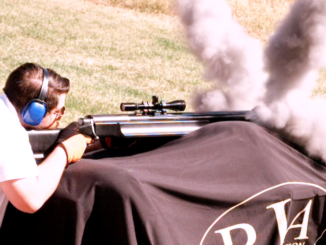RIA’s catalog page for this pistol
William Walker Marston was born in 1822, and would spend his career as a gunsmith and gunmaker in New York City. He produced a wide variety of firearms, including pepperboxes, multi-barrel derringers, percussion revolvers, and the breechloading single-shot pistol which we are looking at in this video.
This pistol is based on an 1852 patent Marston received for a cartridge which used a heavy paper or cardboard case and a leather base pad. That leather pad appears to have been intended as a self-clean bore wipe, which would be remain in the chamber when fired and then be pushed down the bore by the subsequent round. About 1,000 of these pistols were made, in a variety of barrel lengths (from 4” to 8”) and in all three popular calibers (.31, .36, and .44). While the cartridge was a nice improvement over a muzzleloading design, it was apparently not practical or innovative enough to become a real commercial success compared to the other types of combustible cartridges appearing on the market in the 1850s.
The tang sight on this pistol is rather interesting, as it seems to be usable only if the pistol is held very close to the eye. This suggests to me the use of a simple wire stock, although there is no evidence of such a thing being fitted to the gun.




Some observations and notes.
First, I suspect that rather nasty-looking little “nail” driven through the frame hole at the heel of the butt is probably filling a hole drilled crossways to allow the attachment of a homemade wire stock. The grip panels have been crudely carved or whittled away at that point, which would be consistent with the need for clearance for such an attachment. There may even have been an attaching iron pinned in place there, to allow the stock to be detachable.
The rear “peep” sight seems a bit high relative to the front sight for shooting at typical pistol ranges. If used with a stock however, it could have been intended for longer ranges, in which case its elevation would allow for the rainbow-like trajectory of a low-velocity black powder round such as would be used in this pistol.
Next, note the way the barrel is attached. It is either screwed in or crush-fit, with a cross key like the barrel group of a Colt percussion revolver. The purpose of the key is obviously both to ensure that the barrel stays put, and also to ensure that the front sight is properly aligned with the rear sight(s).
Speaking of the barrel, its six lands and grooves rifling is irresistibly reminiscent of the Whitworth’s hexagonal bore, although what might be called the “execution” is more like a modern-day Heckler & Koch pistol’s rifling.
The leather (or more often greased felt) patch may have acted as a breech seal, in fact it probably did, but generally in doing so it was sufficiently scorched that the next round being inserted tore it in two rather than forcing it forward to scour fouling out. I’ve often wondered how many times a smouldering bit of such a patch set off a freshly-loaded round, especially one with a nitrated paper case body.
The overall form of this pistol, and its muzzle-loading forebears, puts all of them firmly in the class of “boot” or “boot leg” pistols, commonly carried by gamblers, crooked or otherwise, down the tops of their English-style riding boots (hence the name). They could be drawn in a hurry if somebody started counting the Aces in play and came up with five rather than four.
Fun fact; the double-action “bar hammer” searage on Allen pepperboxes was first patented for use on Allen’s earlier single-shot boot pistols. Which meant that unlike the Marston and most others that had to be thumb-cocked “on the way up”, the Allen single-shot could be fired without that formality. Accuracy wasn’t great, but at across the poker table or down to the end of the bar range, it was good enough.
Oh, and Marston’s three-barrel derringer? Here it is;
https://fws-files.s3.amazonaws.com/uploads/website/auctions/items/full/175682_1.jpg
and
http://media.liveauctiongroup.net/i/27430/24380708_1.jpg?v=8D36B99689F98B0
Showing the left side with the trademark and etc.
Note that the barrel selector works a lot like the old “tap action” flintlock two-barrel pistols. And that the number “0” means that with the “tappet” turned to that position, the pistol cannot be fired. An early mechanical safety.
cheers
eon
Stock or no, North American handgun shooters in those days seemed to have adopted the bent-arm shooting stance, as seen in prints of duelists in France and even in Frederick Remington paintings of the Old West. All those miniscule sights were held quite close to the eye, in those cases where the gun muzzle wasn’t held against your target. Sometimes your shooting hand was draped over your other forearm, held horizontally in front of you in the manner of a towel rack. It took the 20th century, and Mssrs. Keith, Weaver, and Ayoob, to figure isometrics as part of pistol shooting.
http://regionaux.free.fr/armes/photos/tir_tintin_original.jpg
Like this?